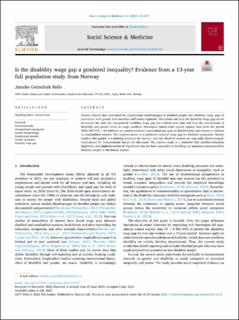Is the disability wage gap a gendered inequality? Evidence from a 13-year full population study from Norway
Peer reviewed, Journal article
Published version
Permanent lenke
https://hdl.handle.net/11250/3097398Utgivelsesdato
2023Metadata
Vis full innførselSamlinger
- AFI Notat [44]
- Publikasjoner fra Cristin [3256]
- SPS - Documents [424]
Originalversjon
10.1016/j.socscimed.2023.116077Sammendrag
Recent research has confirmed the employment disadvantages of disabled people, but disability wage gaps in
interaction with gender have not been sufficiently explored. This article asks how the disability wage gap can be
accounted for, how the unexplained disability wage gap has evolved over time and how the intersections of
disability and gender relate to wage penalties. Norwegian nation-wide annual registry data from the period
2005–2017 (N = 8.5 million) are used to estimate longitudinal pay gaps of disabled men and women in relation
to nondisabled workers. The analyses arrive at a persistent residual wage gap for disabled employees. Results
confirm that gender is a defining predictor for income, and that disabled women are especially disadvantaged.
Implications for intersectional theory are discussed. The current study is a reminder that antidiscrimination
legislation and implementation of regulations has not been successful in levelling out injustices experienced by
disabled people in the labour market.

